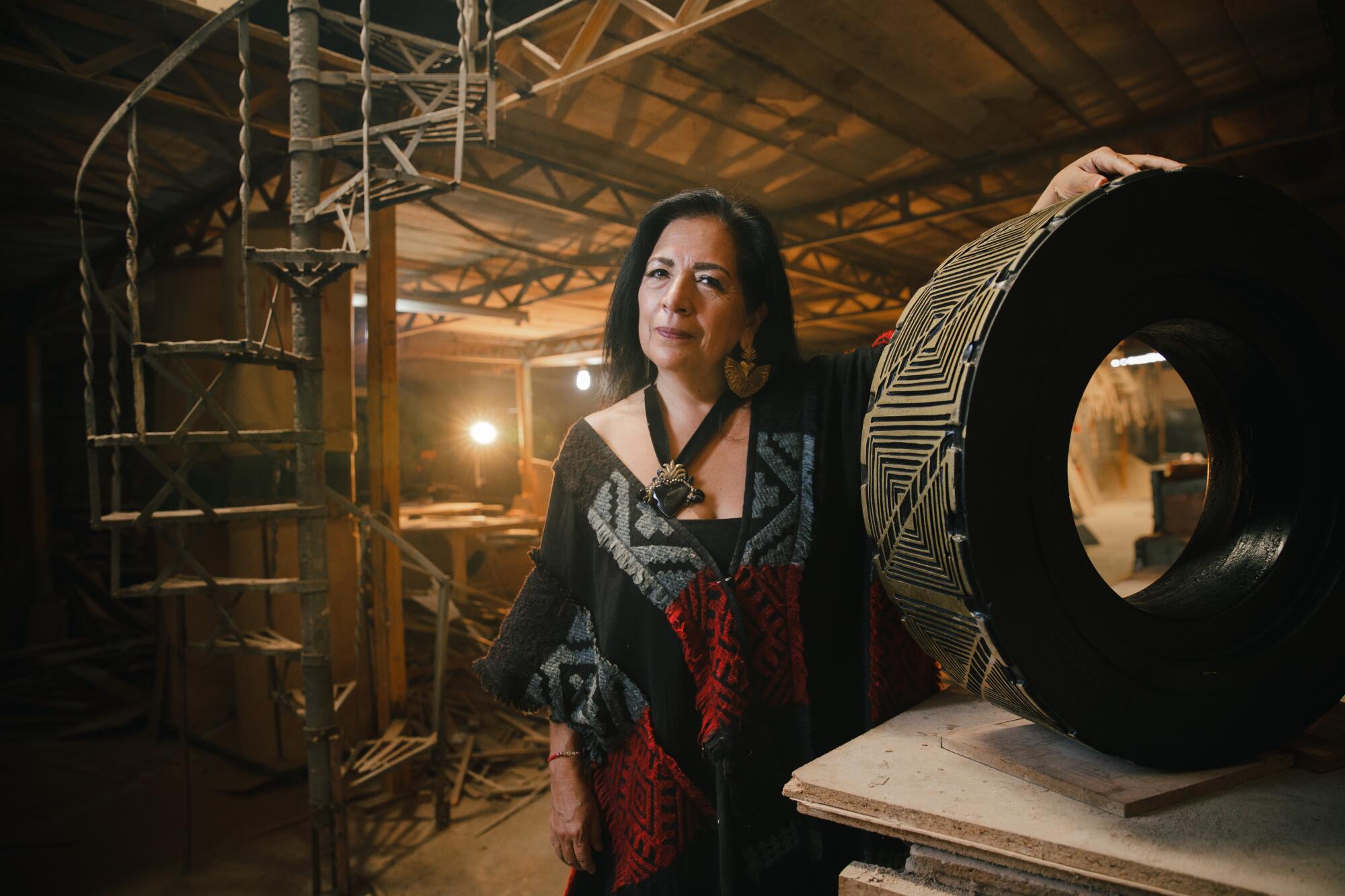
Old tires become artistic totems in the hands of Betsabeé Romero, whose profile is rising thanks to an exhibition timed to the Venice Biennale that will come to Long Beach.
- Share via
MEXICO CITY — “Call me Betsa,” she says with a beaming smile, moments after putting down the phone with the Museo de Arte Moderno in Mexico City.
Betsabeé Romero had just confirmed her latest installation: an arched bridge constructed with the welded metal shells of five vintage Volkswagen Beetles, which have since been unveiled as a key piece in the MAM sculpture garden.
Romero’s work, which often centers on immigration, forced movement and borders, is getting a new level of exposure and recognition this year. Her solo exhibition in Italy, one of 30 events chosen as official extensions of the Venice Biennale, opened to baying crowds in April around the same time her giant public installations were being seen by millions of New Yorkers on Park Avenue. She installed five giant tractor tires there, each engraved with pre-Hispanic symbols that merge with interlocking patterns and images of Maya gods to help “dignify the memories of migrants.”

Her six-part exhibition in Venice, “The Endless Spiral,” pays tribute to those who have no place of refuge, those whose lives are a circle of running from violence and barbarism, interrupted only by political and economic borders. The show will move from Italy to the Museum of Latin American Art in Long Beach next year, and in the meantime, another of her signature tractor-tire artworks greets visitors just outside MOLAA’s entrance.
So it’s with understatement that Romero, 61, says it’s been “a very busy year.” Her studio, though, feels relaxed when she meets for an interview, her sun-drenched space set in the leafy Alamos neighborhood of Mexico City.
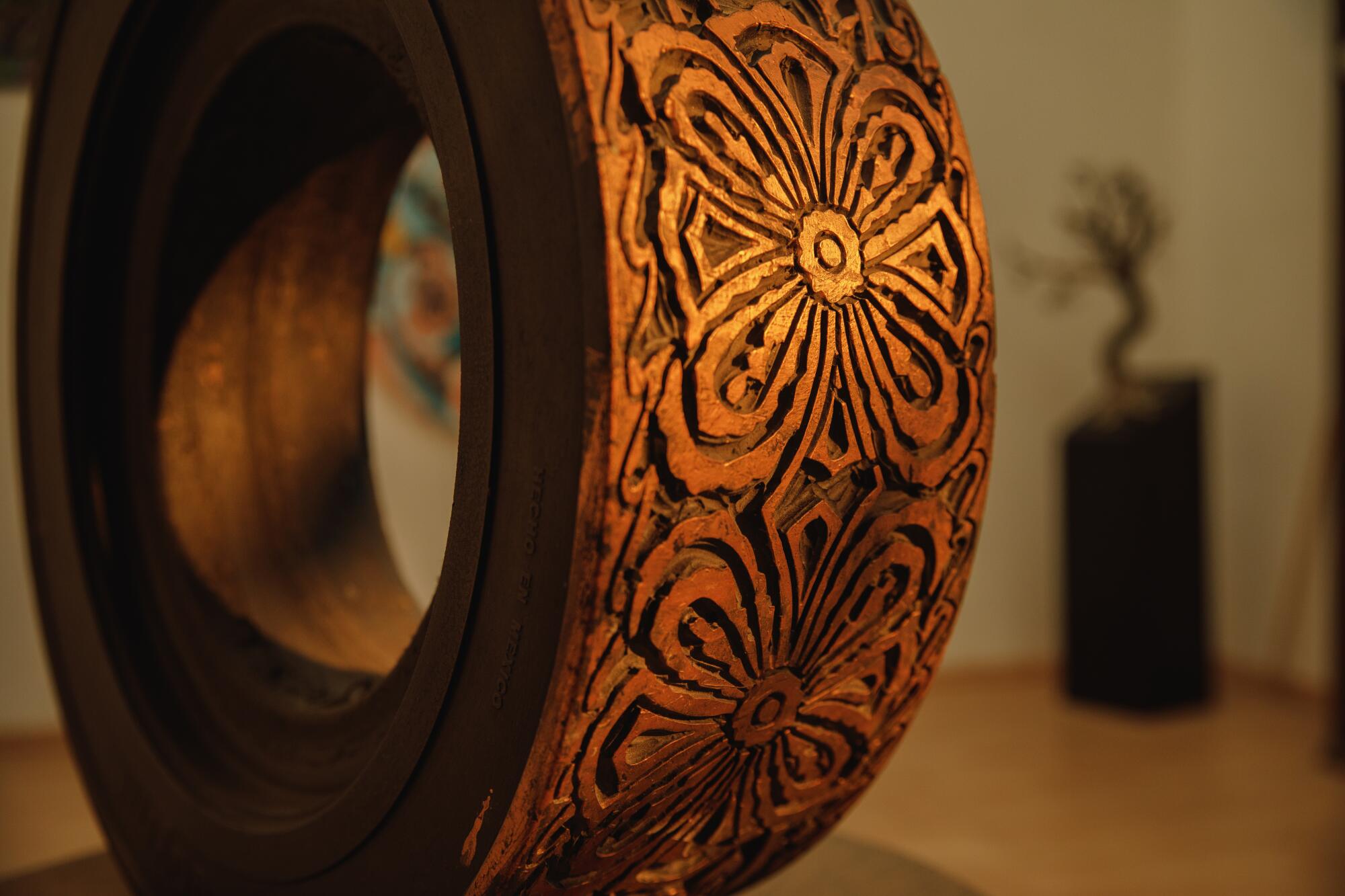
It has been a long road for the artist to reach this point. In a 1997 L.A. Times review, art critic Christopher Knight noted Romero’s inclusion in a border-themed group exhibition of art made for public spaces in San Diego and Tijuana. “Betsabee Romero has radically feminized the classic boy toy, gilding the chrome on a 1955 Ford, painting its canvas-covered exterior in a lush floral pattern worthy of an offering to the Virgin of Guadalupe and filling its interior with layers of dried roses,” Knight wrote. “The car is parked, nose down, atop a steep hill in Colonia Libertad, where it appears to have miraculously jumped the nearby border fence.”
She has since buried car frames in a mountain of corn kernels in a Mexico City plaza, brought her distinct Latin American iconography to the Louvre in Paris, and delivered Day of the Dead traditions to the historic Victorian glasshouse at Kew Gardens in London. Her more recent installations in Manhattan, part of a Fund for Park Avenue commission, will be on view through October.
“Getting art in public spaces isn’t so easy, but I fought hard for it in New York,” she says as her gaze settles on a small replica of one of her tire sculptures.
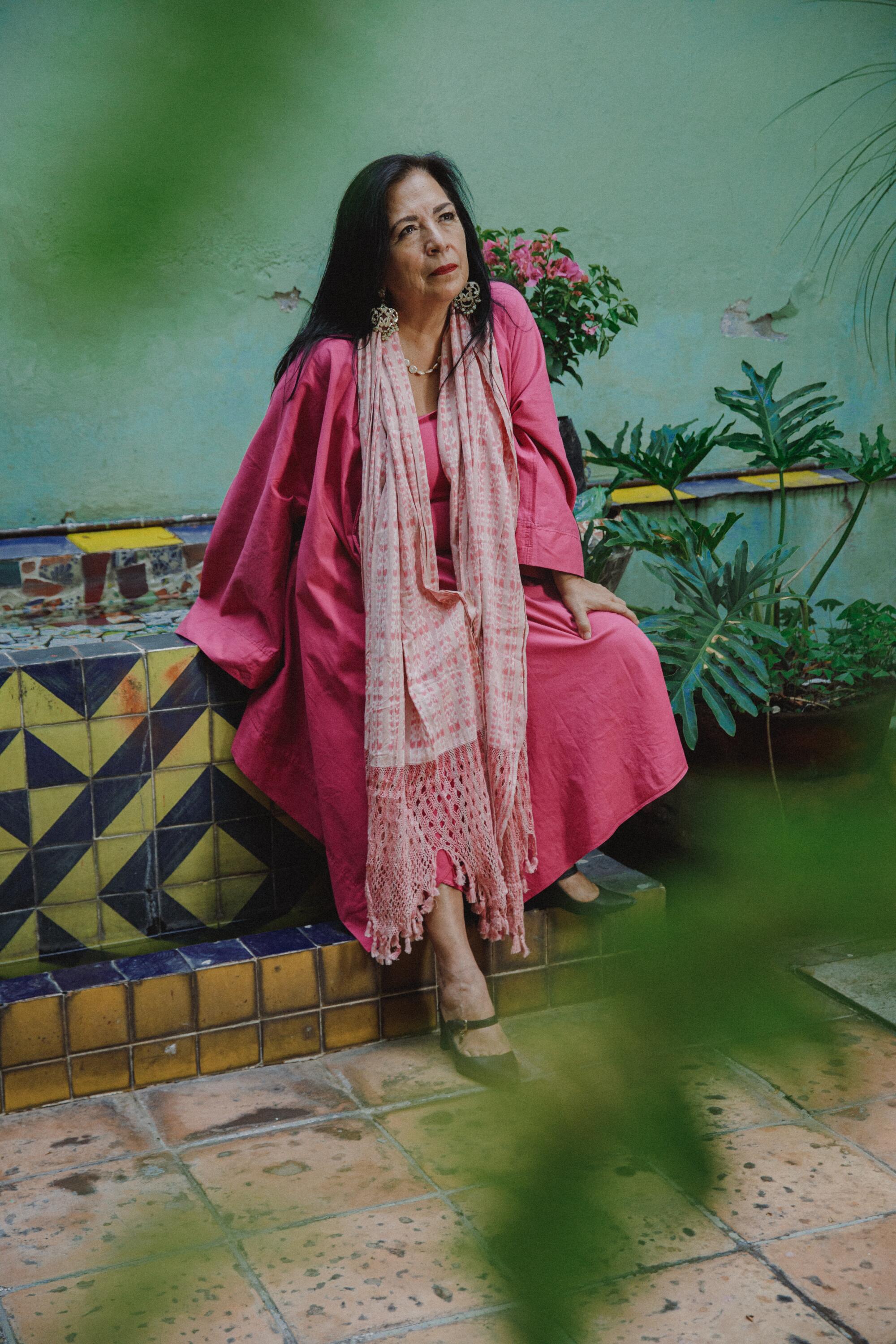
“The memories and cultures of migrants are often lost when they leave or are forced away from their homes,” Romero says. “But I want them to feel a sense of pride in their origins in Latin America and beyond.”
Inside her studio, some of her favorite pieces from more than 100 solo exhibitions around the world are flanked by towering pillars of tires, stacks of steering wheels and disused hubcaps. Painted car doors hang next to framed portraits on the white walls. A wooden bookcase piled with works of pre-Columbian history, archaeology and artist catalogs sags in the middle. The metal steps up to her studio, which could be mistaken for a mechanic’s workshop, are rusted and steep, built as if to keep curious parents out of a childhood den.
“It used to be the first floor of the house I grew up in, but I converted it after returning from my studies in Paris, so I could spend hours producing alone,” she says. “It became my squat in Mexico City, the place which influenced my work the most.”

Studying in Paris for three years refined her technique, but the artist’s style was honed by her home city: a raw, industrial, violent, creative and unpredictable megalopolis during her formative years.
A romance permeates Romero’s voice when she reminisces about the suffocating smog, exhaust fumes and plumes of ash and smoke from volcanic eruptions that from time to time engulfed the city where she was born. When she imitates the thrum of diesel engines that accompany most of her childhood memories, it’s with heartfelt nostalgia.
“I was always fascinated by the car,” she says. “It means something different to everyone: function, fashion, design, style, but also acts as a symbol of status, class, movement and opportunity.”
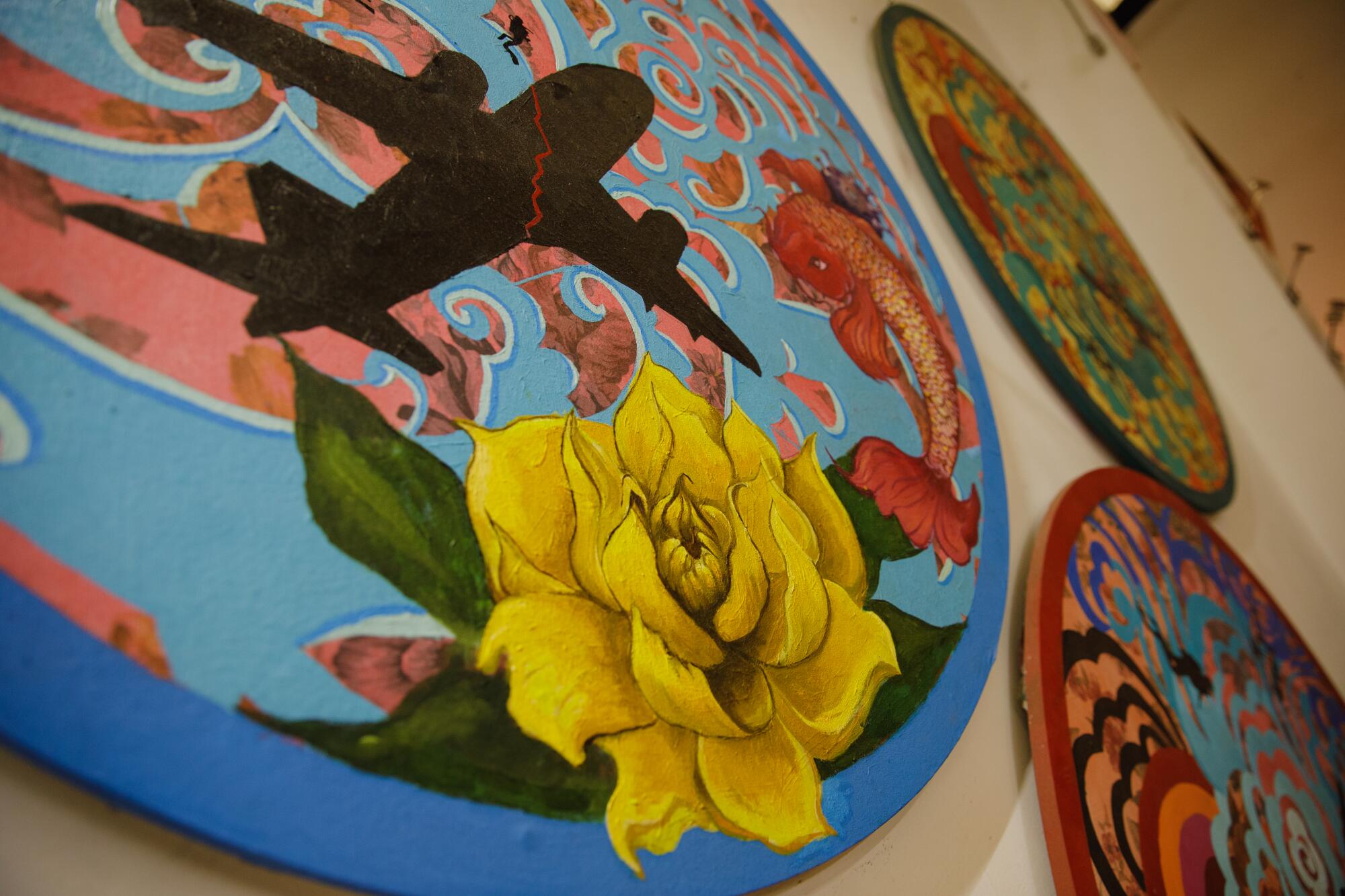
MOLAA curator Gabriela Urtiaga, a longtime admirer and the driving force behind the Venice exhibition, describes Romero as “a nomadic spirit, always looking for new experiences and perspectives.”
In 2001, Romero received an Absolut art festival commission to create five cars representing Latino culture in Los Angeles. By then, she had established herself as part of a community of emerging, young Mexican artists looking for a foothold in the art world.
“I needed to find car parts quickly and cheaply to use there. Spare, used, recycled, broken, I didn’t mind!” she says with a grin.
“The car communities I had worked with in Mexico City had family north of the border who worked in the junkyards around east California. They’d often get spare parts from there because they were much cheaper.”
When Romero arrived at one of these desert junkyards, she says she couldn’t believe her eyes.
“I saw a treasure trove.”
Column: 1984 Olympic Arts Festival all but reinvented L.A. Why the 2028 Games could do the same
As planning for a Cultural Olympiad begins, a look back at how the massive 1984 Olympic Arts Festival 40 years ago revolutionized the L.A. arts scene
Romero lost all sense of time as she sorted through thousands of spare parts with locals who were eager to lend a hand.
One day a local reporter and photographer arrived at the junkyard. After they got their pictures and quotes, they said it was the first time they’d been to the neighborhood for a culture story. Before that, they’d been asked only to report on crime.
“Everyone in the car trade there wanted to help and support me, often more than galleries and curators do,” she says. “It was a beautiful time for me and one of the most important in my career.”
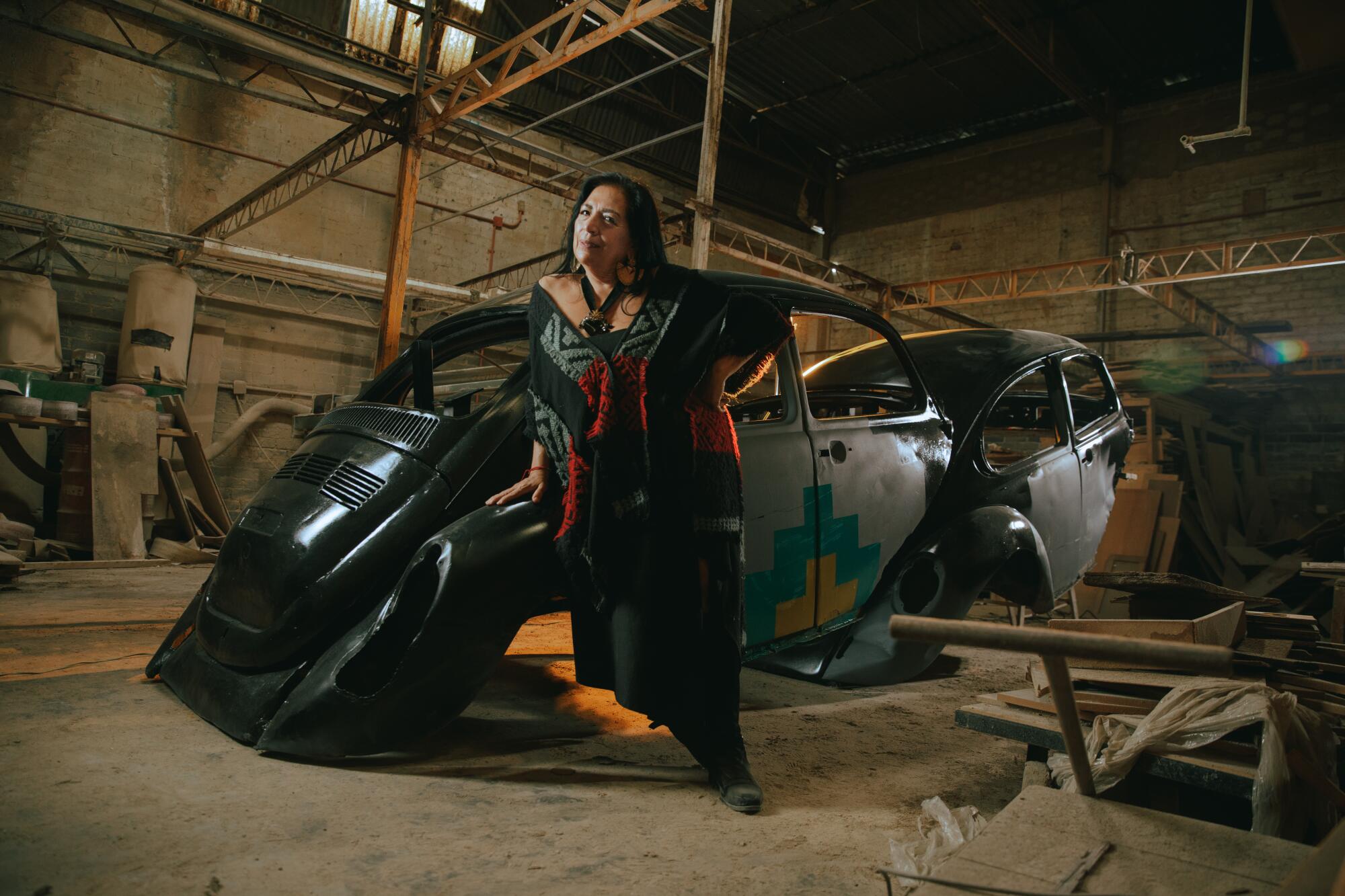
Her forays in and around Los Angeles do include obvious stops like the Los Angeles County Museum of Art, but her favorite neighborhood to explore is Little Tokyo. She recently joined the fandom for “Night + Market” on Sunset Boulevard in WeHo, and her favorite spot to eat is Morihiro in Atwater Village.
Back in her Mexico City studio, the conversation swings to the power of art to address society’s problems. Despite her unflinching zeal, Romero is frank in acknowledging that there are limits to that power. And yet she must try. Her drive is fueled by “reflecting on the injustice around us, and using it as a form of resistance.” She takes pride in supporting the struggles of immigrants and dissecting physical and psychological borders in society.

Romero also speaks about the importance of making art accessible to the least fortunate, and her voice falters as she opens up about one project in particular.
“My friends told me I was crazy for not organizing any security for my Day of the Dead exhibition in Mexico City’s Zocalo in 2016,” Romero recalls while turning to a photo of the 113 boat-shaped altars packed with handmade bowls, bottles and fruits — all of which she built and placed throughout the capital’s main square. “They’ll take it all as soon as it’s dark,” she mimicked her friends with a jovial voice.
“But after they told me that, not a single piece had been taken by the 700,000 people who came to see it during the week. I broke down in tears. People had chosen to add tributes, letters and personal belongings to my altars for their lost loved ones instead. It felt like the most personal, powerful and rewarding review I had ever received.”

More to Read
The biggest entertainment stories
Get our big stories about Hollywood, film, television, music, arts, culture and more right in your inbox as soon as they publish.
You may occasionally receive promotional content from the Los Angeles Times.











